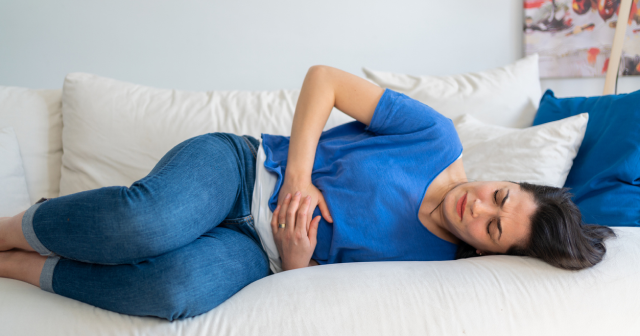Overview
The menopause is when your periods stop permanently. The time from when periods become irregular until they stop altogether is called the perimenopause.
Migraine headaches may become more common during the menopause and perimenopause due to falling levels of the hormone oestrogen in your body. This can happen just before a period starts, as well as during the perimenopause and menopause when oestrogen levels naturally decline. As a result, women are more likely to experience migraines than men due to fluctuating hormone levels.
Other symptoms of the menopause – such as hot flushes, mood changes and poor sleep – can also trigger migraines.
Following the menopause, the number of migraines you experience may reduce as your hormone levels settle.
What do menopause migraines feel like?
A migraine is often described as a severe headache, often pulsating in nature. It usually occurs on one side of the head and is often associated with nausea, vomiting and a heightened sensitivity to light or sound. Migraines often stop you being able to live normally and do what you want to do. They can last from a few hours to two or three days.
Migraines affect people differently. For example, migraines can occur with or without an ‘aura’. This is the name given to a group of symptoms that can occur shortly before a migraine headache occurs. They include:
- visual disturbances such as flashing lights, seeing zig-zag lines or dark spots
- dizziness
- numbness and tingling
Some people who experience migraine headaches don’t have an aura, while others have aura symptoms but without the headache. This is called a ‘silent migraine’.
Migraines without aura symptoms are heavily affected by falling oestrogen levels. This type of headache is therefore common during the perimenopause. It can also be linked to erratic or heavy periods at this time.
Migraines outside of perimenopause and menopause
It’s possible to have migraine headaches outside of the menopause. These can have a range of triggers, including:
- emotional causes, such as anxiety, stress, tension, excitement and depression
- physical causes, such as tiredness, poor shoulder and neck posture, low blood sugar levels and jet lag
- dietary causes, such as missing meals or eating irregularly, dehydration, or eating certain foods such as chocolate or citrus fruits, or drinking alcohol or caffeine. Foods that contain a substance called tyramine may also cause migraines. Tyramine is found in cured meats, yeast extract, pickled herrings, smoked fish and certain cheeses such as Stilton, cheddar and Camembert
- environmental causes, such as bright or flickering lights or screens, smoke or strong smells, loud noise and changes in room temperature
What’s the treatment for hormonal headaches?
Some lifestyle changes, identifying triggers and taking medication can help to manage migraine.
A healthy lifestyle can help reduce the number of migraines you experience. Ways to achieve this include:
- maintaining a healthy weight and eating a balanced diet
- eating at regular times
- staying well hydrated and limiting the amount of alcohol and caffeine you drink
- taking regular exercise – this can also help to reduce stress and anxiety
Can HRT help treat menopause headache?
Hormone replacement therapy (HRT) can be very effective at treating perimenopause migraine symptoms.
Already experiencing migraines doesn’t rule you out from taking HRT, but it’s important to find the type and dosage of HRT that’s best suited to you. HRT replaces the falling levels of oestrogen in your body, but some forms of HRT can create more hormone fluctuations, which can trigger migraine symptoms. This is most likely to occur with HRT tablets. If you get migraines, your doctor may suggest using HRT oestrogen patches or gel, as these maintain more stable hormone levels with fewer fluctuations. Unless you’ve had a hysterectomy, you may also need to take the hormone progestogen to protect the lining of your womb from thickening in response to the oestrogen.

Other treatments for perimenopause migraines
Non-hormonal treatments are often used to treat migraines. These include:
- painkillers, such as paracetamol, aspirin and ibuprofen. These work best if taken at the first sign of a migraine. They work fastest in soluble forms as these are absorbed more quickly into your body than tablets. Always ask your doctor or pharmacist for guidance and make sure you follow the instructions provided in the packet. Ibuprofen and aspirin, for example, aren’t recommended for people with a history of stomach ulcers, liver problems or kidney problems. You can also buy combination medicines for migraine without a prescription at your pharmacy. These can contain painkillers and anti-sickness medicines – your pharmacist will be able to advise which one is best for you
- prophylactic treatments - ones which are taken every day in order to prevent a migraine happening - can be used if your migraine attacks are having a significant impact on the quality of your life and daily function (such as if they occur more than once a week on average) or they’re prolonged and severe despite treatment. They can also be used if your acute treatment is not working, or there is a risk of medication-induced headache due to frequent use of acute drugs. Examples include beta-blockers, amitriptyline and topiramate.
- triptans, which are painkillers specifically designed to treat migraines. They’re often prescribed if paracetamol, aspirin or ibuprofen don’t work. It’s thought they work by reversing changes in the size of the blood vessels in the brain that are believed to be linked to migraine. Possible side effects include flushes, tingling and feelings of heaviness in the limbs and chest
- anti-sickness medicines. Although not painkillers as such, anti-sickness medicines can sometimes treat migraines even if you don’t experience feeling or being sick. These are prescribed by a doctor and can be taken alongside with painkillers or triptans. They work best if taken as soon as a migraine starts
- acupuncture, which is a type of complementary or alternative medicine. This may help if medicines are unsuitable or do not prevent migraines. A course of up to 10 sessions over a one to two-month period may be used to help treat migraines. This is a treatment you may have to pay for privately
Menopause headaches and natural remedies
Some people who get migraines try taking natural supplements. There are many different supplements that claim to help treat migraines and headaches. However, only a small number have evidence to support their use. These include B2, magnesium and co-enzyme Q10, an antioxidant that the body produces naturally (it’s also found in foods like meat, fish and nuts). Feverfew is a herb often taken to treat and prevent migraines, but there’s limited evidence to support its effectiveness. It’s always best to speak with your doctor before taking supplements for migraines. This can help ensure that the supplements are not only safe, but also that they do not interact with other medications you may be taking.
What’s the outlook for menopause migraines?
Perimenopause migraines are triggered by alterations in hormone levels. Once these hormone changes have settled after the menopause, most people find their migraines go away. This can, however, take many months or even a few years. Effective treatments are available to manage the symptoms and reduce the number of attacks you experience. If your migraines are caused by something other than your changing hormones, it’s possible that symptoms will continue after the menopause and require ongoing treatment.
When to see a doctor for hormonal headaches
Call an ambulance or go to your local emergency department if you have a bad headache with:
- paralysis or weakness in one or both arms, or in one side of your face
- Trouble speaking or slurred speech
- severe pain that’s unlike anything you have experienced before
- a high temperature
- a stiff neck
- confusion or drowsiness
- seizures
- double vision or blurred vision
- persistent vomiting
- pain when you touch your touch scalp
- An aura that lasts longer than an hour
- dizziness that started suddenly
These symptoms may be a sign of a more serious condition, such as meningitis or a stroke, and should be assessed by a doctor urgently.
You should see a doctor urgently if:
- you have severe migraines or if painkillers aren’t easing your headaches
- your headache is worse when you cough, sneeze or bend down
- your headaches are worse when you stand up, or when lying down
- people you live with have similar headaches
You should also make an appointment to see your doctor if you have migraines for more than 5 days a month, even if they can be controlled with medicines – you may still benefit from preventative treatment.
Your health questions answered
Can I still take HRT if I have a migraine aura?
 Answered by: Dr Roger Henderson
Answered by: Dr Roger HendersonYes, you can. Unlike the combined hormonal contraception, which you shouldn’t take if you have migraine aura, HRT uses natural oestrogen. It produces levels of oestrogen similar to those produced by your body during a menstrual cycle. If you’ve got an aura that worsens or starts for the first time when taking HRT, it may mean your HRT oestrogen dosage is more than you need. Your doctor may adjust the dosage so that it is just sufficient to control your menopause symptoms.
How do I know if I have migraine headaches?
 Answered by: Dr Roger Henderson
Answered by: Dr Roger HendersonFirstly, you usually need to have ‘episodic headaches’ that last 4 to 72 hours. Episodic headaches are headaches that occur up to 14 days of the month. If that’s the case, then answer these three questions: does light bother you when you have a headache, do the headaches stop you functioning normally, and do you feel sick with the headache? If the answer to at least two of the three questions is ‘yes’, then you may be experiencing migraine headaches.
Key takeaways
- migraines may become more common during the menopause and perimenopause due to falling levels of oestrogen in your body
- migraines without aura symptoms are common during the perimenopause
- a healthy lifestyle can help reduce the number of migraines you experience
- HRT can be very effective at treating perimenopause migraine symptoms
- once hormone changes have settled after the menopause, most people find their migraines go away







